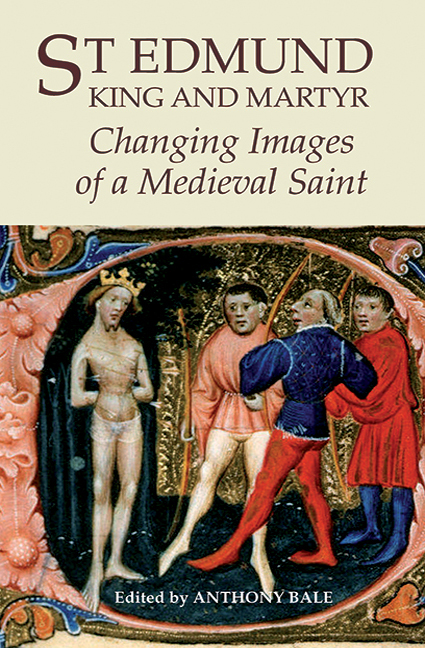Book contents
- Frontmatter
- Contents
- Preface
- List of Contributors
- List of Abbreviations
- Introduction: St Edmund's Medieval Lives
- 1 King, Martyr and Virgin: Imitatio Christi in Ælfric's Life of St Edmund
- 2 Chronology, Genealogy and Conversion: The Afterlife of St Edmund in the North
- 3 Geoffrey of Wells’ Liber de infantia sancti Edmundi and the ‘Anarchy’ of King Stephen's Reign
- 4 Music and Identity in Medieval Bury St Edmunds
- 5 Medieval images of St Edmund in Norfolk Churches
- 6 John Lydgate's Lives of Ss Edmund and Fremund: Politics, Hagiography and Literature
- 7 St Edmund in Fifteenth-Century London: The Lydgatian Miracles of St Edmund
- 8 The Later Lives of St Edmund: John Lydgate to John Stow
- Select Bibliography
- Index
- Miscellaneous Endmatter
Introduction: St Edmund's Medieval Lives
Published online by Cambridge University Press: 11 May 2017
- Frontmatter
- Contents
- Preface
- List of Contributors
- List of Abbreviations
- Introduction: St Edmund's Medieval Lives
- 1 King, Martyr and Virgin: Imitatio Christi in Ælfric's Life of St Edmund
- 2 Chronology, Genealogy and Conversion: The Afterlife of St Edmund in the North
- 3 Geoffrey of Wells’ Liber de infantia sancti Edmundi and the ‘Anarchy’ of King Stephen's Reign
- 4 Music and Identity in Medieval Bury St Edmunds
- 5 Medieval images of St Edmund in Norfolk Churches
- 6 John Lydgate's Lives of Ss Edmund and Fremund: Politics, Hagiography and Literature
- 7 St Edmund in Fifteenth-Century London: The Lydgatian Miracles of St Edmund
- 8 The Later Lives of St Edmund: John Lydgate to John Stow
- Select Bibliography
- Index
- Miscellaneous Endmatter
Summary
In the following pages I will introduce the vitae and cult of St Edmund, providing an overview of the chronology of Edmund's life, a brief account of the role of the abbey at Bury St Edmunds in Edmund's cult, a history of how the cult was celebrated, and a survey of some key scholarly approaches to medieval hagiography. For scholarly studies of medieval Bury St Edmunds the enduring work of M. R. James, M. D. Lobel, Antonia Gransden and Rodney Thomson remains essential; their scholarship provides a comprehensive context to monastic and cultural life at Bury, that context in which the cult of St Edmund was constantly nurtured, performed, promoted and revised.
The vita of St Edmund: a chronology
The outline of Edmund's life is conventionally given thus: Edmund, king of East Anglia and martyr, was born around 840 (later traditions state he was crowned as a youth, in 855); he was killed by Danish invaders on 20 November 869. At Hoxne, a Suffolk village, a monument now stands to Edmund, marking the putative site at which his martyrdom is said to have taken place. In a passage discussed in greater detail below by Carl Phelpstead (pp. 30–31), the near-contemporary Anglo-Saxon Chronicle (compiled c. 890) merely records that Edmund fought the Danes, the Danes were victorious, Edmund was killed and the Danes took the land. Another early source, Asser's Life of King Alfred (written in 893), includes an account of the king's death based on that given in the Anglo-Saxon Chronicle:
In the same year [i.e. AD 869/870], Edmund, king of the East Angles, fought fiercely against that [Danish] army. But alas, he was killed there with a large number of his men, and the Vikings rejoiced triumphantly; the enemy were masters of the battlefield, and they subjected that entire province to their authority.
Neither the Anglo-Saxon Chronicle nor Asser mention a martyrdom ordeal. As is the case with many saints’ lives, there is little in the biography of St Edmund that can be regarded as fact; the story of his life quickly became overlaid with legend, apocryphal narratives and new traditions.
- Type
- Chapter
- Information
- St Edmund, King and MartyrChanging Images of a Medieval Saint, pp. 1 - 26Publisher: Boydell & BrewerPrint publication year: 2009

